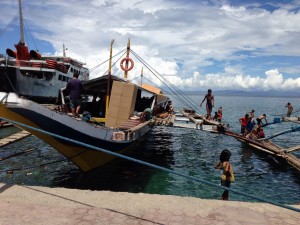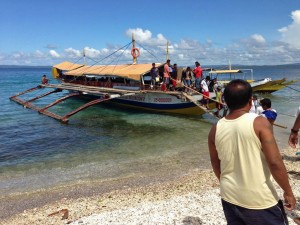[NB: More photos are coming, so check back later!]
Mark had told me that by the time we got to Capul, I would have used every means of transport common to Filipinos with the exception of the carabao, the buffalo. My reply was: why not a buffalo? The people of Capul thought that was great and are even now trying to find me one. I am secretly praying the beast will be unavailable.
So, a 3:45 a.m. taxi ride to the airport leads to a turboprop plane ride across the mountains to Catarman.
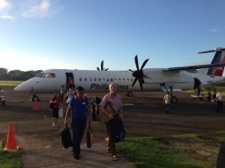
The plane arriving in Catarman
There we are picked up by a motorized tricycle and driven for our appointments in town.
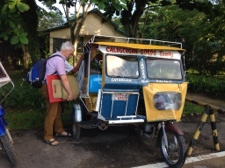
…next, a tricycle…
Following that we climb aboard the “jeepney.” This is a piece of engineering genius: originally it was a surplus WWII American Jeep cut in half and extended to accommodate a dozen or so passengers. Now they are made commercially and used all over the Philippines connecting small towns to each other, the way Greyhound or Trailways used to operate when I was a kid: only these are packed. The photo does not do justice to the efficiency with which this culture can fit an entire village into a shoebox! I wonder if this has something to do with why people are so gentle here. There literally isn’t room for someone with an attitude.
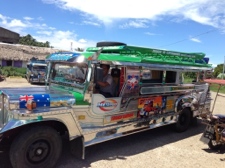
…next, a jeepney…
The Jeepney takes us to Allen, a seaside town named after a WWII American general (I would love to know the back story). We put our luggage on board the outrigger canoe, and hail a pedi-cab for the marketplace: there we pick up some fresh produce, and make it back to the, um, pier in plenty of time.
The boat for Capul is supposed to leave at noon. However, as in a lot of non-Western societies, time here is relational. The hands of my watch go past 12:15, then 12:25. Finally, a bus pulls up with about thirty passengers: they are all Abaknons, of course. So, the lower value (leaving on time) is submitted to the higher value (don’t leave your family behind). Maybe we in the US could do with a little more of this kind of thinking.
The canoe is a marvel: first, it is pull-started, like a lawnmower. Only this thing has twin Diesel engines with screws that must way close to a hundred pounds apiece. These young men get both engines going on the first pull.
The journey across the Strait is uneventful. This is a good thing: during the period of the Spanish galleons, more ships sank here than anywhere else in the world– over 90 wrecks were recorded off the coasts of Capul. When the National Geographic Society came here a few years ago to do a survey of the remains, they found there weren’t any. The swift waters had long since scrubbed the ocean floor, up to 90 fathoms down.
The canoe drops us on the beach at the entrance to the town of Capul, and we are soon on a motorcycle taxi wending through narrow streets which take us to the IHS center. I meet two of Marc’s “mother-tongue” translators, Weny and Reuben, and get a quick tour of the building. It is still under construction, but about two-thirds completed. In addition to the computer room (where I am staying, on a very comfortable cot), there are two kitchens (inside and outside, a Filipino norm), a bedroom and bath for the director, the library, the translations office, and upstairs hostel-style bedrooms for the students who will be in residence. These students, both girls and boys, will come from the three other villages on the island to attend the high school next door to the center. As at Agata House in Manila, scholars here will receive room, board, and a small stipend, and live under the same modified Benedictine rule. The vision is clear: learned Christians, in community, in the world.
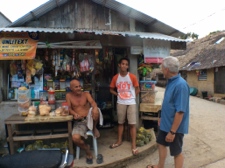
Marc out and about
After a nap, we take a brief outing. By then it is almost six o’clock and the sun has very nearly set. Still, as Marc goes out and about, it seems every ten feet he runs into someone he knows: warm greetings, asking after family, Suzanne, the kids, the grandkids. I am introduced at least a dozen times. I already know the word for “bishop” in Inabaknon, borrowed directly from the Spanish obispo, and when it comes up there are smiles, raised eyebrows, someone takes my hand and either kisses my ring, or touches it to their forehead. (I am going to be impossible when I get home.)
Among those we meet is a member of Marc’s board named Mercy; she is a retired teacher and now on the town council. Her husband Pantit is one of the Center’s translators, and she is a wonderful tour guide. She shows me the old parish church, which dates back to 1496, still surrounded by remnants of the original town walls, and the same spring used by the Spaniards, still an important feature of town life. The crews of the galleons loaded their casks with fresh water here, the last service station until their next stop– Acapulco.
By the time we get back to the Center it is dark. Warren, the Center’s 16-year-old scholar/caretaker, has prepared us a soup for dinner, and by the time it is consumed, I am about ready to fall asleep into my empty bowl. But there is still the Bible Study.
Yes. You remember. The Sower and the Seed? People have been organizing their friends around this for most of the afternoon, and by the time we finish our soup, people are gathering in the library. In a few minutes there are twenty in all. This is a much more diverse group than in Taiwan or Uganda: several members of the Board, half a dozen high school students, some retirees, a couple of young parents. The range in age is from 14 to well over 70! I use the same protocol as before: I do a brief introduction, we go around the room reading the passage (Mark 4:1-20) a verse at a time, in English, then Inabaknon. Then I ask them to divide into three groups to discuss, as specifically as possible, where they find the Hard Ground, Stony Ground or Thorny Ground (respectively) in their own lives. They take about fifteen minutes, then come back to share. There was more than I can report here, but the most interesting emphasis, I think, is the sense of shame.

a few of my new friends
In all three kinds of “soil” there is the recurring presence of the “higher status person” who makes them feel inferior– the idea that what you have to offer isn’t valued, because of others who are higher up in the social ladder. That is the “hard ground” that won’t admit the good word of our infinite worth before the Father. As in Taiwan, the “stony ground” is being made fun of or mocked for their faith, especially among the students; but the “thorny ground” has more to do with daily worries about family, money and children, and I am instantly reminded this is a much poorer community than I was in a few days earlier. At the end, I ask them to go back into small groups and ask one question: where in their lives is the good soil from which God brings the fruit of His Kingdom. When they come back the answers are many and various, but I’m going to save this piece for a later blog!
After prayers are offered, all the good-byes are said, and everyone leaves, I am seriously ready for bed. Marc and I debrief a little, and I head upstairs thinking I might fall asleep on the landing. I do manage to make it to my room, however. I thank God for His mercies, for Marc and Suzanne and the lives of everyone I have met; I pray for Betsy and Evan and the Diocese, but I don’t remember getting more than halfway through the Lord’s Prayer. I pass out somewhere in the middle of “forgive us our trespasses” and not even the persistent evening crow of the roosters, or the weird chanting of the gecko outside my window can trouble my sleep.

